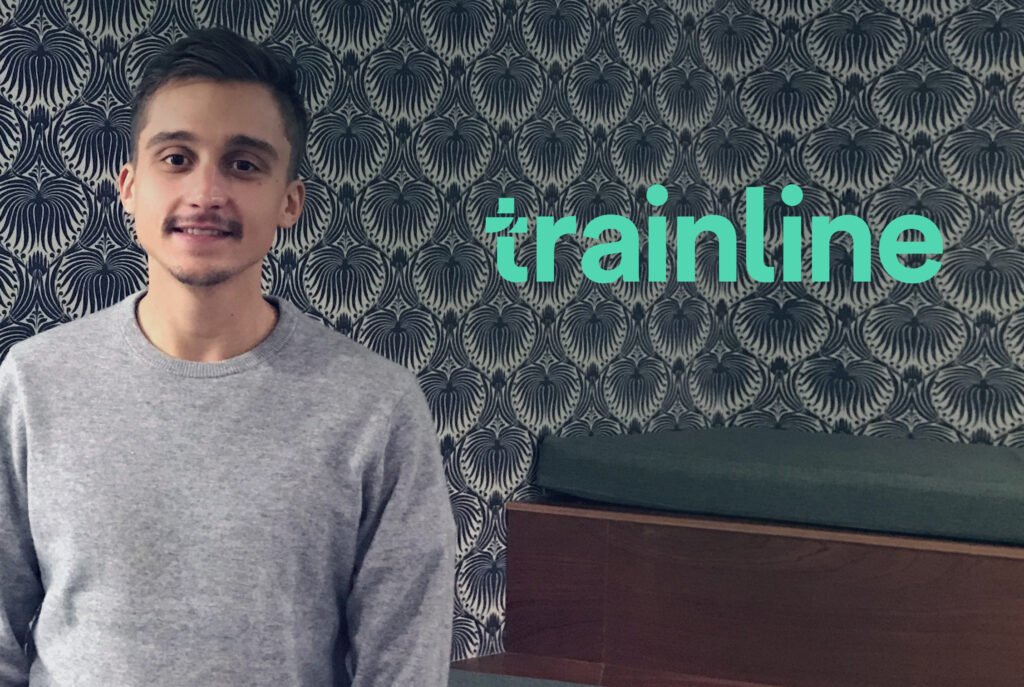trainline is probably one of the most innovative start-ups in the world of transport, with its data-centric approach.
With a simple value proposition – sell train tickets all over Europe – it has stood out from other online booking services. It has made an action that was previously complex simple and quick.

By promising to buy a train ticket with just a few clicks, Trainline is on its way to conquering Europe. We wanted to discuss with them in order to understand what place is given to the User Experience in their strategy, and particularly in their development abroad.
Mounir Laggoune, Country Manager DACH @Trainline received us in their friendly premises. Back to a casual discussion on topics as broad as user needs, recruitment, data, content and of course: design.
Mounir, in a nutshell

Mounir is in charge of the development of the Swiss, German and Austrian (DACH) markets. In his own words, he wears a double hat:
- Make sure consumers can buy tickets on Trainline
- Understand the needs of its customers.

This dual approach between product and end user is the positioning adopted by Trainline.
What will have impressed us during this interview is the state of mind that guides the development of their product. Return on the values which carry Trainline towards the tops.
Value #1: Simplicity
"Cover Europe and no longer have to wonder about buying train and bus tickets".
This is how Mounir pitches the Simple and Efficient service. This goal reminds us don't make me think, Steve Krug's essential book on User Experience. It is a question of facilitating the course so that the user concentrates only on his need.
While each operator only sells their own train tickets, Trainline allows you to buy a journey operated by several carriers without impacting your user experience.
Value #2: Innovation
Discovery workshops are regularly organised. The starting point can be customer service, as well as the data division or even marketing.
All the stakeholders of the course concerned meet for workshops in order to translate user needs into innovation, always with the same question in mind:
“How to make it easier to buy train and bus tickets?”
The hypotheses adopted come from numerous design thinking workshops involving the technical teams, the marketing teams, the customer service and of course the designers. Taking into account technical feasibility, consumer desires and business needs makes it possible to create new opportunities and innovations.

The new functionalities are then built in Test & Learn via AB Testing, Mutli Versioning Testing (MVT), in particular. This is followed by a phase of analysis and iterations in order to arrive at the best proposal. This Lean phase allows great flexibility in adapting courses to markets and user needs. Thus, Trainline is able to offer the same service adapted to all its markets.
Value #3: Empathy
“Data is at the heart of their approach.”
Through the mass of information collected, Trainline has developed its own analysis tool in order to be able to work on the raw data and then refine it thanks to its teams of data scientists and analysts. This valuable source is one of the inputs for user-centered thinking.
“We record the needs, so we facilitate the uses. For example, we always show the smoothest route.”
In addition to this quantitative approach, there is a qualitative approach by setting up focus groups across Europe. Thus, functionalities can be born during these workshops. We will not know more. (Secret!) We should soon see something new on the app…
Another example is means of payment. In order to be ever closer to its users, Trainline observes, listens and adapts to the habits of the different markets.
For example, in the German market, customers mainly use the app. Everything is recorded there. In order to increase the rate of use, they have chosen to integrate payment methods that are very popular across the Rhine, such as Paypal or Sofort. Indeed, unlike in France, the bank card is not a very popular means of payment in Germany.
Similarly, in the Netherlands, customers are offered to pay with iDEAL, which accounts for approximately 40% of online payments across e-commerce globally.
The objective is to remain focused on the uses of customers so as not to add additional tension to them...
Value #4: Opening
"We are happy that our customers spend little time on our site or app because the reservation is simple and fast. "
Mounir reminds him, Trainline wants the user to find their ticket as quickly as possible. Thus, a user can buy a ticket without having to register first.
“We pick up users when their experience is good.”
For Mounir, the travel experience begins when the customer buys their ticket and ends when they have completed their journey.

From there, the points of contact with the service are numerous. The challenge is to offer the right timing to its user. Thus, Trainline offers many advantages to registered persons: registration of discount cards, passengers, platform announcement via notifications, possible delays, etc.
This positioning could seem risky in terms of loss of customer knowledge. However, it is through this strategy that Trainline has been successful. By focusing exclusively on the needs of its users, it develops a unique service based on a strong relationship with the brand.
Value #5: Customer relationship
We all know that taking the train can be a stressful experience at times. Also, Trainline has opted for very high quality customer service. Here, there is no robot to process complaints and send standardized responses. The start-up bucked the trend by opting for a team of customer relations experts. These “real people” are even considered the heart of the value of the service. They are able to send personalized responses to each customer.
“A negative experience often becomes a channel for acquiring new customers.”
Thanks to this very efficient service, they are able to trace all the problems encountered by users. This data is then centralized in a tool specially developed by Trainline.
Value #6: UX Content
Adaptation of content is also a very present line of work at Trainline. The localization of the application according to its markets brings a strong added value.
“You have to put yourself in the shoes of users who are not used to taking the train or the bus. They don't have the same questions at all. It is therefore necessary to accompany them according to their problems. “
For example, a Swedish customer can use the application in his language. Similarly, an American customer will not be disconcerted: even if the train is not very developed in the United States, when this customer travels in Europe, he will use a service adapted to his culture without hesitation. Trainline accompany them.

The content is worked on in small touches depending on the country. Thus, Trainline does not address a German in the same way as an Italian. A focus is made on what people expect.
Conclusion
Trainline has based its business on improving the daily lives of its customers. Thus, the application is 100% accessible to visually impaired people.
At term, “[they] would like to have all the trains and buses in the world.” Because the world is changing, the company moves forward with the times while being convinced that the user experience is driven by the entire team.
“You can't pretend to be nice. Otherwise, it's brainwashing.”
This state of mind is noticeable as soon as you walk through the door. It is even surprising to find the spirit of the application in their premises. However, Trainline is not content to be nice. It seeks to constantly innovate in its sector. Thus, its teams are working on new media such as voice in particular.
What will have impressed us during our interview is the consideration of the user during all stages of product design and development.
Sebastian (@SebfaureUX), Learning & Development Manager @UXR_Training – Head of Content @UX Republic
STORYTELLING: THE ART OF CONVINCING # Paris
SMILE Paris
163 quay of Doctor Dervaux 92600 Asnières-sur-Seine
UX/UI ECO-DESIGN # Paris
SMILE Paris
163 quay of Doctor Dervaux 92600 Asnières-sur-Seine
DESIGN THINKING: CREATING INNOVATION # Belgium
UX-REPUBLIC Belgium
12 avenue de Broqueville - 1150 Woluwe-Saint-Pierre
MANAGING AND MEASURING UX # Paris
SMILE Paris
163 quay of Doctor Dervaux 92600 Asnières-sur-Seine
DESIGN SPRINT: INITIATION & FACILITATION # Paris
SMILE Paris
163 quay of Doctor Dervaux 92600 Asnières-sur-Seine
UX-DESIGN: THE FUNDAMENTALS # Belgium
UX-REPUBLIC Belgium
12 avenue de Broqueville - 1150 Woluwe-Saint-Pierre
GOOGLE ANALYTICS 4 #Paris
SMILE Paris
163 quay of Doctor Dervaux 92600 Asnières-sur-Seine
ACCESSIBLE UX/UI DESIGN # Belgium
UX-REPUBLIC Belgium
12 avenue de Broqueville - 1150 Woluwe-Saint-Pierre












